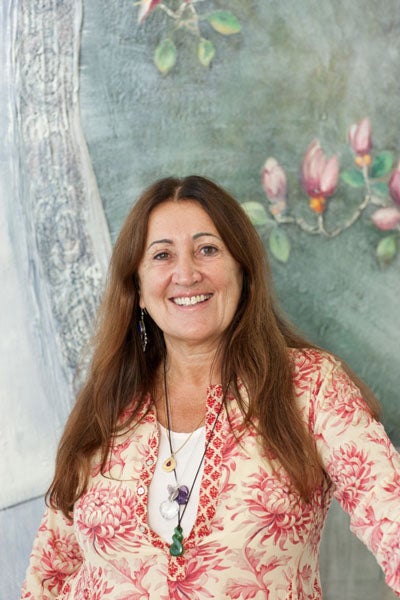Creating a feminine space for female entrepreneurs
With the help of Shabby Chic designer, Rachel Ashwell, lifestyle guru and entrepreneur Lynne Franks has created a working environment that reflects ‘the feminine way of doing business’, says Emily Jenkinson.

White painted tables, pretty cane chairs, crystal chandeliers, flora-inspired murals, vintage tea sets, decorative screens, fringed lampshades, pot plants, beautiful paintings and wall art. It doesn’t sound like your typical business environment, does it? But former PR queen and lifestyle guru, Lynne Franks has never been one to follow the crowd.
Search for the perfect furniture with The Independent house and home database, powered by mydeco
Back in the early 70s, aged just 21, she founded what was to become one of the UK’s best-known public relations consultancies, representing a mixture of high street brands such as Harvey Nicols and Tommy Hilfiger, fashion designers such as Katharine Hamnett and Jean-Paul Gaultier and entertainment stars such as Annie Lennox and Ruby Wax.
Famed for her flamboyant personality and colourful dress sense (and widely assumed to be the inspiration for Jennifer Saunder’s character, Edina, in Absolutely Fabulous), Franks favoured a macrobiotic diet, became a Buddhist and embraced yoga, meditation and other New Age trends long before it became fashionable to do so.
In 1993, after resigning as chairwoman of Lynne Franks PR, Franks was again ahead of her time when she started campaigning for sustainable living alongside women’s empowerment and developed the Sustainable Enterprise and Empowerment Dynamics (SEED) as a model for using principles of femininity, sustainability and social responsibility in business.
Her 2000 book, The SEED Handbook: The Feminine Way to Create Business was an international best-seller that expanded on this ethos and helped form the building blocks for her latest venture, B.Hive, which, in typical Franks fashion, seems set to revolutionise the way women do business. So what is B.Hive and how did it come about?
“Well,” says Franks, “I’ve been working for women entrepreneurs for a number of years and I didn’t feel that there was a space out there that really reflected the needs of women in terms of a feminine place where they could network and work from. Then I met Mark Dixon, who is the CEO for Regus [the world’s largest work space provider] and I thought ‘this is perfect.’”
Dixon obviously thought so too, and agreed to collaborate on B.Hive as a more female-focused business lounge, where an ever-growing community of like-minded women entrepreneurs and freelancers could, as Franks says, “work together according to the feminine principles of community, connection and collaboration.”
B.Hive’s flagship lounge, which opened in September in London’s Covent Garden, aims to promote these principles by embracing beautiful design. Interior designer Rachel Ashwell, worked alongside sustainable design specialist Elina Grigorious to bring her trademark vintage, romantic style and furniture to the B.Hive interior. Mural artist Charlotte Adler of Cabbages & Roses was employed to theme the lounge with affirmations from Franks’ SEED Handbook, Meanwhile, celebrated American artist Natasha Zupan is currently exhibiting her ‘Pollination’ show of paintings inspired by women and relationships.
Next year, B.Hive lounges will open in Birmingham, Reading Manchester, Bristol and Glasgow. While Rachel Ashwell will continue to design the interiors, Franks plans to work with local women artists, designers and even caterers in each location, as a way of celebrating local women’s achievements and encouraging a sense community.
A deep sense of community is already in evidence at B.Hive Covent Garden, despite it only being open eight weeks. “I love it because every time we go there we connect with journalists, other business owners and women who are looking for the inspiration to start their own enterprise,” wrote Genevieve Murphy of cotton tampon company, Trinkets, on her blog recently. “Opportunity knocks at B.Hive and you never know who you are going to meet when you come down the antique spiral staircase.”
So where do male entrepreneurs and businessmen fit into B.Hive? Are they allowed down the spiral staircase? And, if so, do they benefit from this more creative working environment in the same way that women do?
“The men love it, and we do have men who come,” says Franks. But, she says, “it’s quite interesting: when there are a few men there, they speak louder – the women are all quite quiet – and it changes the energy tremendously. We’re not saying men can’t come, but, you know, Regus has 1,000 other work spaces all over the world so….”
The message seems clear chaps: women are realising that they don’t have to work to a male schedule or do business in a male way to have a successful and fulfilling career – they can set their own rules – and if that means doing business in a more homely and attractive work space, then who are you to stop them?
Emily Jenkinson is interiors writer for furniture and interior design website mydeco.com
Join our commenting forum
Join thought-provoking conversations, follow other Independent readers and see their replies
Comments
Bookmark popover
Removed from bookmarks